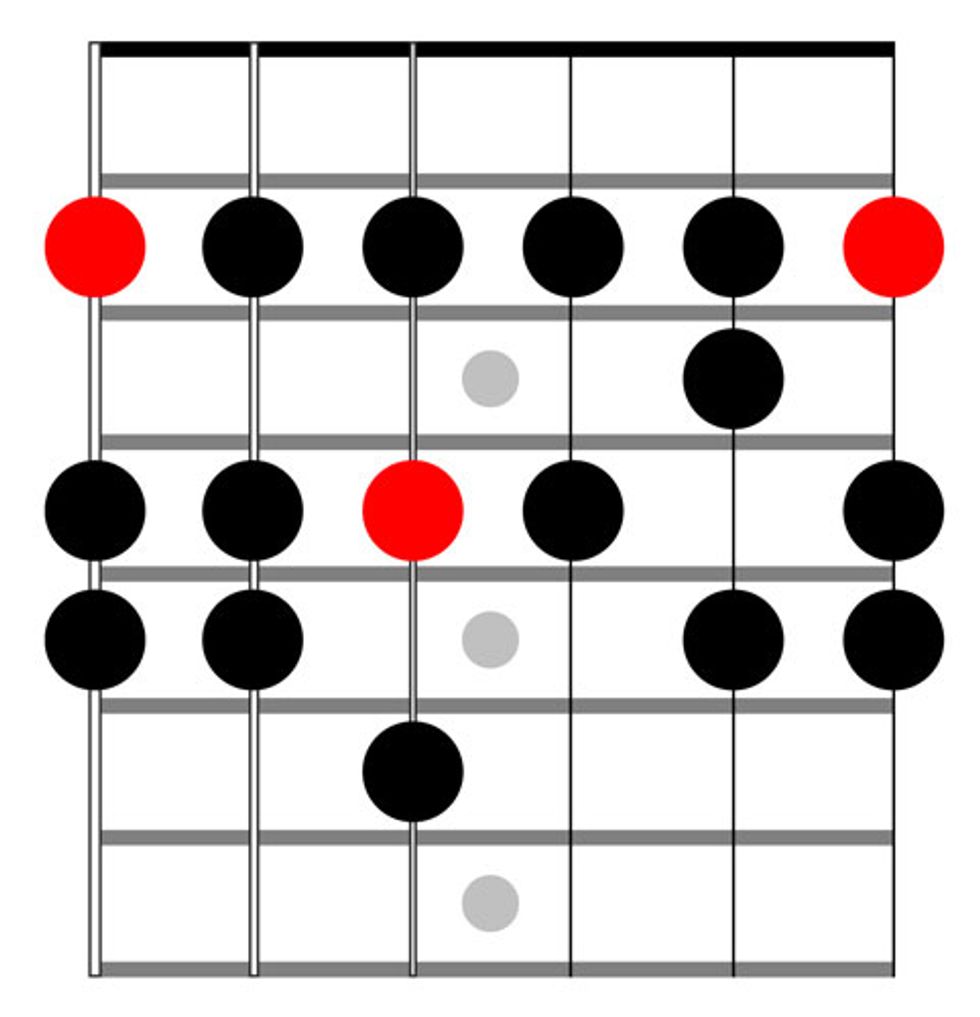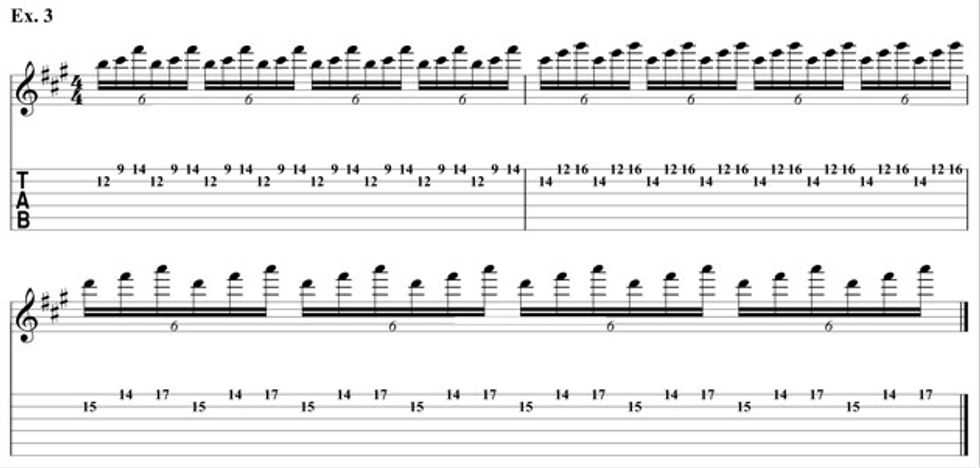In his debut blog, Zakk Wylde takes us back to 1987 and talks about how the scales he learned as a teenager tie into the first song he ever wrote with Ozzy.
Hello there, my brethren and sisters o’ doom! Big Black Label thanks to the gang at PG for allowing me to talk about what we all breathe and bleed for—the love of guitar!
Since this is our first gathering, I figured I’d start off talking about the first riff/song I wrote with Ozzy Osbourne some 27 years ago. “Miracle Man” will always hold a special place in my heart, being that it was the first thing I wrote with The Boss. It was 1987, and Ozzy and I had just begun writing No Rest for the Wicked in Brighton, England. We were jamming in a horse stall that had been converted into a living space/rehearsal studio. There was a cozy little pub with a beer garden within walking distance, and the routine basically consisted of jamming riffs all day, then going to the pub and sitting in with the house band. Nothing but good times, indeed!
When people ask me how I came up with the guitar parts, I tell them I used St. Hendrix’s “Foxy Lady” fingering. I was messing around with that, then I sped it up a bit, added some 16th-notes and some Marshall chunk, and next thing you know it’s “Miracle Man.” But while you can find note-for-note performances of the rhythm and solo on YouTube, a lot of players don’t understand the method behind the madness.
When I was 14 and decided I was going to dedicate my life to the guitar, I was blessed with having an amazing guitar teacher named Leroy Wright. He taught me songs by my favorite bands to keep it fun, but he also taught me scales, chord inversions, and the theory behind why it all worked. See, it’s awesome to learn your favorite players’ solos—like Pope Page’s “Stairway to Heaven” solo, or St. Rhoads’ “Mr. Crowley” solo—but do you know how those solos were created?
Scales, scales, and more scales.
When Leroy explained scales to me, it was like seeing an amazing card trick from one of your friends, and then having it broken down and explained. Mystery revealed! That’s the power of scales.
When I learned the blues lick in “Back in Black,” that was a major breakthrough for me—that, technically, I could actually play it. But having Leroy show me why it worked was just as huge. Like having a car engine with parts scattered everywhere, then being shown how this part connects to this part and so on. Each part serves a purpose.
So when an aspiring guitarist asks me for advice, I tell them to learn their fretboard. In other words, learn how a basic scale that you might play in one spot on the neck maps out across the entire fretboard. When you do that, it opens up endless possibilities for different fingering patterns and note combinations—because even though they’re the same notes, they have a different character and vibe on different parts of the neck.
For instance, I built the “Miracle Man” solo around the F# natural minor scale (aka F# Aeolian, F#-G#-A-B-C#-D-E), which starts on the 2nd fret of the 6th string (Ex. 1). See all those red dots? Those are all the F# notes in the scale—they’re kind of like the home base for the solo.
Next, take a look at the diagram of the entire guitar fretboard in Ex. 2. Even though this looks complicated, these are exactly thesame notes as Ex.1. Don’t believe me? Check it out: If you start playing the notes in Ex. 2 on the 2nd fret of the 6th string, but play four notes on that string instead of just the three shown in Ex. 1, you’ll see that the note on the 7th fret of the 6th string sounds just like the one at the 2nd fret on the 5th string. Experiment some more, and you’ll hear how all the other notes in Ex. 1 map out just like Ex. 2 shows—only they branch off into higher octaves as you go up the neck.
And it’s a repeating pattern, too. See how the same basic pattern from Ex.1 starts all over again once you get up to the F# octave at the 14th fret on the 6th string? Memorize the pattern from Ex. 2, because you’re going to be using it for the rest of your guitar-playing life.
Okay, now let’s see how this figures into the first part of the “Miracle Man” solo. We’re not going to tackle the entire solo note-for-note, because the main point here is to learn the larger lesson of how scales map out across the whole neck to give you a blank canvas of soloing possibilities.
This is important: When I recorded the song, I was tuned down a half-step, so if you’re referencing the original track, you’ll want to retune to Eb standard.
The solo begins with what I call “the triplet” section, because each one has a repeating three-note pattern—only these patterns are played in the part of the F# Aeolian scale that’s up at the 9th fret and beyond.
As you’ll see in Ex. 3,each measure has a different three-note lick that’s played eight times: twice per beat in each 4/4 measure. This makes them sextuplets. Whoa, gotta love the sound of that! Check out the tab to see where the notes are located on the fretboard.
The patterns start with a note on the 2nd string, followed by two notes played on the 1st string. Start slowly and be patient. As you keep working on picking these patterns cleanly and with a steady, even rhythm, you’ll be able to work up to the speed on the recording.
The next section of the solo (Ex. 4) will take even more patience and slow practice, because it features two quickly picked four-note patterns inspired by fusion guitar great John McLaughlin. These patterns alternate: The first four-note pattern falls on beats one and three, while the second pattern falls on beats two and four.
Next, the solo repeat the licks from Examples 3 and 4, but you get a bit of a break after that: Instead of repeating the fast, four-note licks from Ex. 4, you only have to play a bend on each beat of the measure. But listen closely—this measure has six beats instead of the usual four.
The second half of the “Miracle Man” solo changes keys to C# Aeolian (C#-D#-E-F#-G#-A-B). This might sound confusing, but it actually illustrates what I was talking about when I said my teacher Leroy opened my eyes to the mystery of writing songs, riffs, and licks. We’re not going to dissect this part of the solo, but if you start playing the fretboard map from Ex. 2 along with the recording—only starting up at the 6th string’s 9th fret instead of the 2nd fret—you’ll hear that it fits in with what I’m playing in the last half of the solo. And if you mess around long enough, you’ll probably figure out some of the licks I’m playing! Just remember to tune down a half-step before you try to decode these licks.
Before I go, let’s talk real quick about the final step in unlocking your whole fretboard and learning how to solo like your heroes: The fancy scale names you hear guitarists talking about in lessons or interviews—stuff like the Mixolydian or Dorian modes—are actually right there inside the pattern in Ex. 2. The different names simply refer to where you start within that fretboard map. Each of these seven different starting points (or “modes”) can give a song a unique feel when you build your chord schemes around these note combinations. [Ed. note: For more details on this, check out “Visualizing the Modes” by Herman Li at premierguitar.com/lessons.]
Stay strong/bleed guitar.
—Zakk






